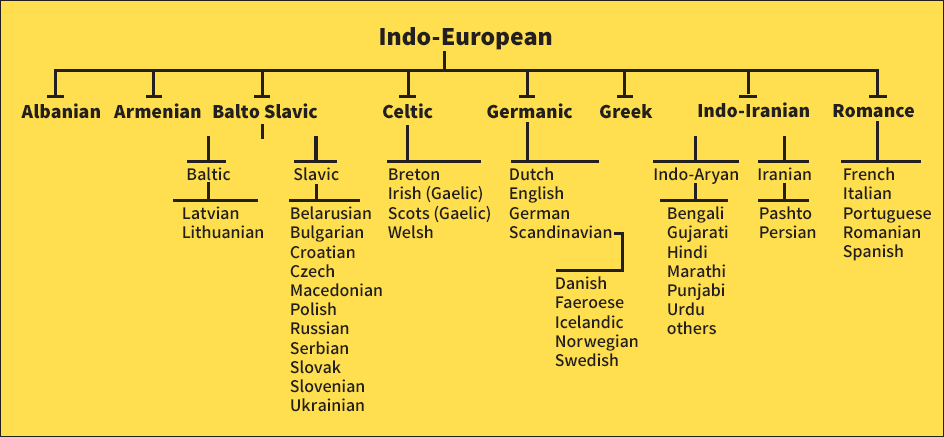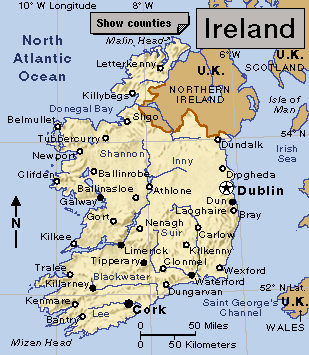In Ireland, you’ll hear sláinte <<SLAHN cha>> in nearly all your daily activities. Sláinte means health in Irish, the national language of the Republic of Ireland, and the word is used much as cheers is used in English. Irish is the country’s first official language, but more people in Ireland speak English, the second official language. In the Irish language, Irish is called Gaeilge (Gaelic).
Irish belongs to the Celtic branch of the Indo-European family of languages. About 40 percent of the Irish population claim they speak Irish, though few people practice the language in everyday life. Areas of Ireland collectively called the Gaeltacht speak Irish as their first language.

Irish uses letters of the Roman alphabet. But the alphabet uses j, q, x, and z only in foreign and technical words. The letters k, w, and y are not usually used in modern Irish. Nouns are either masculine or feminine. Most verbs are regular. Irish has only 11 irregular verbs (English has more than 80). In simple sentences, the word order is verb, subject, object. For example, “I bought a book” in English would be “Bought I a book” in Irish.

By the start of the Christian era, Irish was spoken throughout Ireland and had spread into Scotland, the west coast of Britain, and the Isle of Man. The Christian missionary Saint Patrick introduced the Roman alphabet to Ireland in the A.D. 400’s.
Norman conquerors from France began to settle in Ireland near the end of the 1100’s. Gradually, they began to speak Irish along with the native population. Classical Modern Irish began to develop in the 1200’s and lasted through the 1600’s. During that time, literary standards for Irish were set that persisted until the 1900’s. English also gained ground in Ireland during that time and was increasingly used for official and legal business in the cities. Irish was the dominant language in most rural areas.
By the early 1700’s, colonists and landowners from England and Scotland largely replaced the old Irish-speaking ruling class. The native gentry who remained adopted English as their everyday language. Irish lived on as the language of the peasant class.
In the 1830’s, the British government established national schools in which English was the official language. During the Great Famine of the 1840’s, about 2.5 million people, many of them Irish speakers, died or left the country. According to the census of 1891, there were fewer than 700,000 speakers of Irish, compared with 1.5 million in the 1861 census.
In 1893, the Gaelic League was founded to revive the use of Irish and to encourage the study of Irish literature. The organization has remained through the years and is a major force today in protecting and promoting the Irish language.
Untitled Document
Can't view the linked articles? Subscribe to World Book Online

World Book Online delivers a progressive sequence of core databases supported by supplemental
tools, such as language translation, graphic organizers, and unique Webquests. Moving from
Early World of Learning to World Book Advanced, World Book Online aligns end-users with their
appropriate learning levels. Each stand-alone site provides additional features to support the
needs of users’ specific capabilities.
The World Book Difference
World Book combines cutting-edge technology with traditional editorial excellence to produce
authoritative, trustworthy, and unbiased content. The digital content is updated in real time and
carefully curated for each learning level. Accessible 24/7, the content is available on a variety of devices.
World Book Online combines 21st-century instructional techniques with timely information.
By breaking down complex topics and using easily understandable text, World Book Online helps to
build fluency and increase comprehension. Featuring single sign-on capability, these sites are paired
with highly visual content to engage even the most reluctant reader. Our collection of resources kindles
a lifelong learning experience for every user. This adherence to clarity, currency, and accuracy makes
World Book’s digital offerings an information hub for the classroom, library, and beyond.
Image 1: The flag of Ireland. Credit: © T. Lesia, Shutterstock
Image 2: Indo-European is the most widespread language family today. Credit: WORLD BOOK diagram
Image 3: Irish is the first official language of Ireland.
Credit: WORLD BOOK map